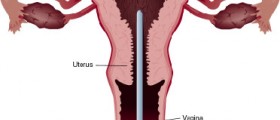
Endometrial cancer is a malignant tumor originating from the endometrium, a layer of the uterine wall. This tumor affects the body of the uterus unlike cervical cancer which originates from the epithelium of the cervix, lower portion of the uterus.
Endometrial Cancer: Causes and Risk Factors
This malignant tumor of the uterus is considered quite common. Its occurrence seems to be closely related to estrogen stimulation. Namely, estrogen, one of female hormones, stimulates build-up of the lining of the uterus and may eventually initiate abnormal development of certain cells and cancer formation.
It is estimated that this type of cancer predominantly affects women between the ages of 60 and 70 and is rarely reported in women younger than 40.
The risk for endometrial cancer is high in women suffering from diabetes, those on estrogen replacement therapy (ERT without progesterone), women with a history of endometrial polyps, infertile women, women with infrequent periods, women taking tamoxifen as a treatment for breast cancer, women who have never had children, obese women as well as those suffering from polycystic ovarian syndrome. Even early onset of menstruation (before the age of 12) or menopause occurring after 50 years of age may contribute to development of endometrial cancer.
Endometrial Cancer: Symptoms and Signs
In the majority of cases the presence of endometrial cancer is closely connected with unusual vaginal bleeding/discharge as well as pain in the pelvis.
Furthermore, each woman who has experienced bleeding/discharge not related to menstruation, painful urination, difficulty urinating, pain during intercourse and spontaneous pain in the pelvis is due to consult her gynecologist as soon as possible.
Diagnosing Endometrial Cancer
The location of endometrial cancer does not allow doctors to take samples in a way they do when a woman is suffering from cervical cancer. So, instead of a Pap test, doctors take samples of the uterine lining and examine it microscopically.
One of the procedures performed to obtain sample tissue is endometrial biopsy. It is performed with the assistance of a tiny, flexible tube which is inserted into the uterus. The tube gently scrapes uterine wall and taken tissue is further analyzed. Another way to obtain samples is by performing dilatation and curettage.
Endometrial Cancer: Treatment Options
Treatment for endometrial cancer depends on many factors including the stage of the disease, patient's general health as well as comorbidities.
There are several approaches such as surgery, chemotherapy, radiation therapy and hormone therapy. Sometimes doctors opt for more than one treatment. For instance, a woman may be initially operated and then undergo radiation therapy. Surgery is usually extensive and the entire uterus together with the adnexa is removed. Chemotherapy is basically a treatment option for advanced cases of endometrial cancer.

















Your thoughts on this
Loading...